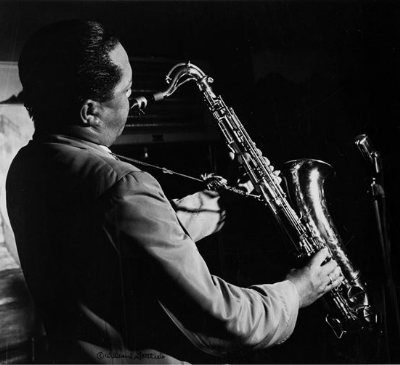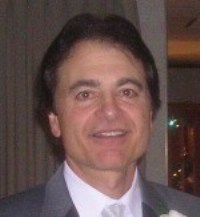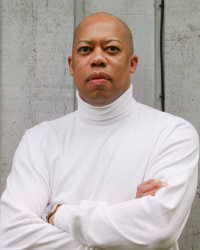.
.
In this month’s collection, with great jazz artists at the core of their work, 16 poets remember, revere, ponder, laugh, dream, and listen
.
.
_______
.
.
photo by William Gottlieb

Lester Young, 1946
.
.
Just Out For a Walk
.(for Joseph Glaser and Robert Fox)
.
downtown small town backstreets
gimping along, walking stick in hand,
my feet beat the street like a drummer
always just behind the beat and all
around me folk create their own music
an old woman on a corner scolding
herself in staccato bursts of sound
Coltrane would have recognized
three wee bairns skip rope and chant
in rhythms Horace Silver might
have included in his best work
a lad bops swiftly through a nearby
intersection with the funky
lightning quick deftness of the mighty
Charlie Parker dancing through a solo
his groove moving at the speed of light
leaning against a wall with the weight
of years and the world two old men
quietly talk talk and talk mixing smiles
and soulful nods as they shake heads
at all they’ve seen and known both
kind of blue conversation sailing
wherever memory and imagination
take them sharing riffs that fit
together with the perfection
of Miles musically chatting
with Cannonball and Trane
and I suddenly realize all life
is music harmonious dissonant
free-flowing stuttering full-throated
whispered celebratory or grief-stricken
all contain melody rhythm (heart)beat
memory and imagination
.
by Michael L. Newell
.
.
___
.
.
The Acrobat
(for Lester Young)
.
Far above the Jazz terrain,
balanced precariously,
a melodic force tumbles forward,
spiraling out, from a tilted saxophone.
The gliding pirouette chases the sunbeams,
unconcerned with risk or situation,
occasionally pausing,
perching in the breeze,
finally jumping downwards, to part the clouds.
On the ground, the orchestra waits,
and the drummer keeps time,
underneath the aerial ballet.
.
by Freddington
.
.
___
.
.
Lips and Valves
.
So I’m listening to Fats Navarro
this morning
he
of the girth unzipping
and the trumpet
the high girl voice
and the trumpet
the short junkie life
and the trumpet
and outside it is raining
and the clouds have nothing to do
and the rivers aren’t listening
and the beaten city doesn’t care
it’s true
and doesn’t care about the nimble beauty of this large fighter
this missile who is not just anyone’s tubercular son
and whose punished soul
if I open the window and let the birds in
flies like a winged soldier from office to office
close to the ceiling
letting go like his trumpet solo on The Chase
or Bouncing with Bud
or Fat Girl
and whose spit
leaves the HVAC system singing in its sleep
above the world he burned—
Lennie T. once said
friend
Dizzy Gillespie is a nice trumpet player
but he’s no Fats Navarro—
as for me
I couldn’t pay rent in this neighborhood
.
by John Stupp
.
.
.
photo by Lee Tanner
Miles Davis, 1991
.
.
Initiation
(State College, 1993)
.
After backpacking
a skunky brick of Mexican
on a long bus ride, the best
Happy Valley has to offer
is a love-seat,
some piss-warm Pabst,
and a gray moray gliding
through a filthy tank
while dusty speakers spill
Bitches Brew,
its low-end grooves
haunting every inch
of this dank room, shuttered
from the coming
fall morning.
Across another lost weekend
those scuffed discs
purists love to hate
keep spinning–
their binge-worthy vamp
keyed to drone and slither,
a table set
for Miles to tap
spines with blasting
echoed notes, electric
pick-ups clipped
to his muted bell
where a full breath can stir
sounds, dark and ominous
to my untrained ears..
.
by Fred Shaw
……………….-originally published in Brilliant Corners
.
.
___
.
.
Dave Holland And His Big Band
.
Dave made the acoustic bass
Roar like thunder
The percussive thumps
Falling in line with the drums
The female singers reminded
Me of mockingbirds
Dressing their vocals
In tones. of silk and
Lace
The horn section roared
Like the A train
I asked him
What was it like
Working with miles?
He said “miles was always
Looking for the next big
Thing, he let artists expand
Their creativity
He let you be you…”
I told him miles’ autobiography
Was the only history I read
And the only story I
Trusted
I have many regrets in life
One, was not seeing miles
Play
But I shook the hand of
The man who played
With miles
I am healed.
by Erren Kelly
.
.
___
.
.
Mind/ful/l
of Miles
.
What’s new?
I too
am kind
of blue,
ear buds
soothing
“So What,”
Chambers
and then
Evans
noodling
Gil E.’s
intro.
Sooo what?
Upright
walks in
the tune,
conjures
modal
three-part
sooo what’s.
No mute
for Miles,
just cool,
crystal-
clearful
riffing.
Sooo what?
Coltrane’s
tenor
takes me…
Jimmy’s
brushing
behind.
Sooo what?
Cannon-
ball’s break
before
more Bill,
then back
as one:
Sooo what?
B-dah
b-dah-
b-dah
b-daaah:
Sooo what?
B-dah
b-dah
b-dah.
b-dah
bah:
Sooo what?
B-dah
b-dah-
b-dah
b-daaah:
Sooo what?
B-dah
bah-bah-
baaah:
Thaaa’s what.
.
by D. R. James
……………….-originally published in Galway Review, January 27, 2018
.
.
___
.
.
Doo-Bopping with Miles
.
8:00 a.m. grooving to Chocolate Chip
Oh shit! Got me making moves I didn’t
know still existed inside of this old girl
rocking to the man, his trumpet transcending
a wave from my head to my shoulders
working down my spine, my hips gyrating
back to a jazzy motherland, working
it to Blow, how low can I go, my
hand up in the air, like I just don’t
care, Miles, transferring me into
Sonya, biting my lower lip, ain’t
this a trip, what galaxy is this
lost in a Fantasy, ain’t no Mystery
Miles done got a hold of me
With his doo-bop, mystic energy
.
by Aurora Lewis
.
.
___
.
.
Coltrane Became Sometimes, I
(For Michael Newell)
Of course I’d switch places with a dolphin
if just to get that chatty load of sawteeth,
show them out while bouncing backwards
on my tail atop waves that I’d just exploded up
through. Make myself a series of arcs, bows,
sweet repeated parabolas, open parenthesis
to sea caps under stratocumulus, sea caps under
the reeling shadows of seagulls, pelicans.
My sine-works stitched between fish gobbles.
Epidermis oiled and cool as Coltrane notes
blown out wet across a club stage. Coltrane
sweating like a mother fucker to get that
sax just half way to dolphin note.
To clear, resounding, jetting shrieks,
vibrant shuttering euphonies. (
and Coltrane himself an epiphanous
crown jewel set atop a million rat’s-ass
musicians that all studied hard but not
one of them and only rarely Coltrane able
to reach what he reached on “Blue Train”
and reached again on “Lush Life”.
So much in love with what the sax
could do that he could hardly bare to
have it out of his mouth as he dove
down into his own veins, shot up
fountains, great plumes of invention.
Different there altogether from the spare
humility of a single reed in wind on shoreline
that he became, wholly and only human,
aching-sacred on “A Love Supreme”
which no dolphin has ever known
enough pain to bring into birth.
He couldn’t get it out of his mouth,
all its innate desire. Held it there,
the sax’s bright, belling brass. Its
curve-works, reed vibrating against
tongue. John William Coltrane sweated
for no other reason than the effort
every day takes, sun’s toll on all of us
who never can raise five notes together
half as sinuous as any dolphin’s or even
travel inward through our own veins.
To have the sudden lustrous grey-blue
arc of me burst up, whirling dervish
through dawn’s wave-works. To sink
down, reel out some tune of moonlight
distilled on the floor of a sea cave.
To then squirt up into constant arcs
of epiphany, shutter forth blasts of joy.
Orgasm transformed into creature.
.
by Ed Ruzicka
.
.
.
.
.
It Must Have Been Ella’s Voice
I
.
It was almost impossible to hear,
but not impossible to listen,
the richness of it,
the spell it cast, emanating from above,
spiraling downward in faint waves,
seizing the day with the enchantment of itself,
dispersing the warmth of itself
into the chill of day,
out of the sky from whatever voice
thrust its magic forward,
a sound that described itself
as it fell, something, rap, scat,
an idea of endless resonance and clarity,
a melody, a rhythmic rendition,
folding upon itself
in a flood of overtones,
varied layers from the echo of itself,
but singular in quality,
its timbre unchanged,
filling the air with the color of itself,
a minute, tender, consoling color,
arresting the ear, high then low,
subtle yet noticeable,
serene motifs interwoven,
jazz modes traveling chromatically,
inducing moods,
bordering on imagined
yet deceptively discerned,
a mysterious charm invading the ear,
falling then rising
only to fall again, a faint interlude
was what it was.
.
.
It Must Have Been Ella’s Voice
II
.
It began again as a lick,
a motif that was the cobalt sky,
the clouds, the trees in the forest
and the flowers that grew between.
It was a sunbeam bent upon the ocean’s froth,
the way it rode the massive swells to shore,
the manner in which
it highlighted matted salt and seaweed
upon the agitated shoreline.
There was more, the theme,
a linear melody becoming
the wind that lifted beach sand,
stung the sky to squint
and puckered the down of static gulls,
culminating in a moment of supreme contentment,
and if anything at all would be known,
it would be an appreciation
of its sensual timbre,
the energy, the love.
It was that and only that,
with the knowledge
that a moment so replete,
so ripe with voice,
would eventually vanish, as it must,
to deem it extraordinary
for no level of longing or prayer
might preserve it.
Only its timbre would remain unchanged,
its remembrance, the sensation it provoked,
buried in the heart, forever lingering.
After many years, it was only that,
reverberating the heavens,
as well as the psyche,
framed in the brain, submerged within,
persisting for hours, days, droning.
An everlasting glimmer. It was just that.
.
by .Michael Keshigian
.
.
___
.
.
Bing With a Dash of Pops
.
Bing could sing with a deep cool tone,
or fling notes with effortless pizzazz —
diddly bop she bop do wop de hop bop,
could whisper low notes smooth and mellow,
or do a musical dance of contrasting styles
with Satchmo himself, that rumbling
guttural bundle of sonic joy,
who would mix and match with Bing’s casual
whimsical stylings to create a musical gumbo
too varied, too original to name.
.
by Michael L. Newell
.
.
___
.
.
Susannah McCorkle
.
She had dedicated fans, seasons of them,
over her rainbow and under, delighted to
greet them all if only she could. Preferred
to be the invisible chanteuse, troubled in
her essence, her thoughts. Channeled all
requests to her pianist, the soul of his
Steinway in perfectly formed empathy.
In the brick-lined corner of Algonquin’s
jazz emporium, nothing pleased more than
notes wavering midair, suspended on unseen
clotheslines, then floating downwards to
chianti-soaked laps protected by slacks
camouflaged in intense violet black.
These nights belonged to Susannah and rainy
streets that ushered the lucky in to drown in
the pond of her voice. Spiritual. Can’t be
bought for a quarter in any roadside jukebox.
Captured audience, all pleasantly warmed
against the wanton cold. Her voice was love,
theirs to enjoy as they saw fit. She was only 55.
.
by Robin Ray
.
.
___
.
.
.
.
.
A Big Pile of Junk
.
Tristano said, let thought come through
Your all ten fingers;
(Or whatever number you must use
To play the blues
Or any tune).
How high The Moon. or. Gershwin’s Soon…
Your thought a boon
If it’s spontaneous, impromptu.
Corwin says the same thing too.
Not filled with an emotive ardor
But the charter of the instinct
And the intuition.
Be as one.
Let musicianship
Take lead, and lead your music
To your still unripe;
No comic gimmick or alchemic hype.
Your hippest self will be your type,
Reveal all your inner hope and razzmatazz.
We’ll call it jazz
Because
That is what a true jazz is.
Tristano
Called his own piano
Nothing but ‘a pile of junk’
To be transformed by Monk
Or anyone whose inmost mind
Uses the utmost energy to find
That inner passion,
Do what’s bidden, always hidden
In the inner sanctum of the shrine
We’ll call your talent.
.
by Arlene Corwin
.
.
___
.
.
Tombeau for Teddy Wilson
.
God bless the relaxed
God bless the dawdler
God bless the languid
who travel uninterrupted
from goal line to goal line
in lit stadiums around the world
like Dennis Bergkamp
the Ajax and Arsenal man
with the elegant first touch
or Andrea Pirlo
or Dimitar Berbatov
the finders of space
and silence
and magic
or
like Teddy Wilson
the jazz tailor
quiet as a sewing machine
at the piano
holding how many bands together
with just two hands
a little fabric
a little stitching
I saw him once in New York
navigate a noisy supper club
he knew every turn
every straightaway
he knew the sea and its tribes
and the rain dropping like a veil
he was in no hurry
to create his masterpiece
and after
I wore his music around town
like a fine Italian suit
.
by John Stupp
.
.
___
.
.
Two Who Have Seen Better Days
.
Exuberant rain dances on a spring window
in concert with Ramsey Lewis unleashing
“Hang on Sloopy” on the radio;
who .would .have . thought it possible
piano, rain, and wind might lift an old man
to his feet in an aging parody of a jig;
the septuagenarian’s ragged voice belts out
those words that can be remembered while
the visitor in the room, an old friend unseen
for years, sings along, misses as many words
as his host in a wild unanticipated toast to life;
neither of these old scoundrels are fit to dance,
much less sing, but both give it all they got, as wind
rises and falls, as rain sweeps away lost and lonely years,
as life flowers in the most unlikely of crucibles.
.
by Michael L. Newell
.
.
___
.
.
There were more interesting things in heaven than Ricardo Montalban.”
– B.J. Novak One More Thing
.
Bill Evans and Toots Thielemans For Example
.
Chromatic harmonica wailing over
piano and drum-brush clock
as I consider Belgium today
suicide-bombed into submission
but Evans tintinnabulates as I lie
as in recline here in my wife’s garden
All seems so sunny and so well
Welfare is anything most seek
After all what else after else
These blues only these concluding blues
far more interesting than almost any other
television celebrity who might end up in heaven.
.
by Ed Coletti
……………….-from Apollo Blue’s Harp And The Gods Of Song, by Ed Coletti
.
.
.
.
.
The Girl from Ipanema
.
In her head,
Antônio Carlos Jobim
played bossa nova.
February sunshine
hinted Rio de Janeiro.
Broken concrete
dressed in Brazilian tile.
Amid a crowd of lovers,
she danced the samba,
ate fresh pão de queijo,
drank cool cachaça.
She walked toward the sea,
but no one saw her.
She smiled again,
but no hearts were given.
Ela não era a garota de Ipanema.
Not as tall and tan, young and lovely,
she wasn’t the girl from Ipanema.
The scenery changed,
the temperature dropped.
The crowd of lovers
faded with the music.
The samba stopped,
her poem lost its mood.
Brazilian tile
left the Brooklyn concrete.
She trashed her devaneiro,
ran back upstairs.
She never noticed the broken tile
outside her door.
Brazilian hearts
made in Brooklyn.
.
by Patricia Carragon
.
.
___
.
.
West Side Story
.
Rita Moreno was my gynecologist.
She climbed in the window off the fire escape
and struck a flamenco pose.
A small gold cross gleamed at her throat.
Her white coat was open, revealing
a short flounced skirt in passionate colors.
The spike heels which grew on her feet
gave her a rhythm which can’t be learned,
an insolence not meant for me.
There was nothing medical about her.
I closed my eyes and watched.
Her chin lifted, her eyes smoldered
as she tangoed toward me. No one
could do those Latin dances like Rita.
She was seductive and knowing,
a woman who calculated risks
and lived with them.
As she took my medical history
I wanted to mention seeing her as Anita,
I wanted to talk with her about “Life.”
I slid down and put my feet in the stirrups.
No surprises, let me tell you:
the speculum was warm.
And the salsa she did on her way out
was hot.
.
by Phyllis Wax
.
.
.
.
.
Charles Mingus
.
Wisdom reached
Down heavy
Ignoring the
Dark brooding
On earth’s face.
Mighty power
Touched heavenly
Long black
Dancing fingers
With a dream.
A fat willing
Wooden bass
Fell in love
With the hands
Of his youth.
His jazzed sounds
Leaned strong
Pushing sweet
His voice
Through strings.
.
by Roger Singer
……………….–previously published on Jerry Jazz Musician, 2013
.
.
___
.
.
Thirteen Ways of Looking at Tal Farlow: Pittsburgh, circa 1982
After Wallace Stevens
.
I
Among twenty silver frets
The only moving thing in Pittsburgh
Were the bare hands of Tal Farlow
II
He was of three minds
Like the Allegheny, the Monongahela and the Ohio River
Each boasting an I Got Rhythm bridge
III
The jazz music whirled in the wind
Like a chemist at work
It was all part of a II-V-I pantomime
IV
A man and a guitar
Are one
A man and a guitar and a blast furnace
Are one
V
I didn’t know which to prefer
The beauty of his single notes
Or the beauty of his chords
Tal Farlow playing
Or just after
VI
Icicles filled the windows
Of the decaying city
The shadow of Tal Farlow the sign painter
Crossed over it
Coloring to and fro
VII
Oh thin men of Lawrenceville
Why do you imagine other guitarists?
Do you not see Tal pulling a rabbit from his guitar?
VIII
He knows all the noble grace notes
And the fascinating rhythm
Known only to Gershwin
And he knows
That Charlie Christian is involved
In what he knows
IX
When his solos fly out of sight
They are like sparks picked from Bessemer
They mark in the night sky
The edges of many burning circles
X
At the sight of his playing
The royal courts of Europe
Cried out
Because they were afraid of jazz music
XI
A man rode home over the rough roads
Of Pennsylvania
And a great trembling overtook him
He mistook the shadow of a bouncing guitar case
For a blackbird
XII
Drums drumming
Tal strumming
Pittsburgh humming
Missiles incoming
XIII
After God made Tal Farlow
He sat him down on a cedar limb
And said he was good
And would turn his attention to poets now
.
by John Stupp
.
.
___
.
.
The Knuckleball Special
(for Warne Marsh)
.
A meandering, stop and start stutter,
the phrases bend and flow,
changing direction,
veering out of alignment,
lines and shapes appear sideways,
forming an arc-like creation,
embedded in logic,
beauty through a convex lens,
a curve ball no one can hit,
a solo by Warne Marsh.
.
by Freddington
.
.
___
.
.
Barry Harris & Charles McPherson
piano solo
……………………& the blind man covers his eyes
……………….trays of brimming hot cups of coffee
…………………………carried & it’s getting closer to closing
……………………time when we bundle up & wrap you around
……………….us & follow the crazy music of our innards
………………………into the cold burning night.
……………….i am fallen from the tree
………………………have turned one color or another
…………………………red – yellow
………………………a chewing quickness of song
………………………the blind man chews gum
…………………………for hrs
…………………..listening to the music’s wild
………………………continuance.
.
by Steve Dalachinsky
.
.
.
_____
.
.
Michael L. Newell is a retired English/Theatre teacher who lives on the south-central Oregon coast. He lived abroad for 23.5 years. After too many years of living in desert lands, he is grateful for the trees, hills, rivers, and rain of Oregon.
.
.
___
.
.
Freddington works as a shipper/receiver in Toronto, Canada, and has been a lifelong jazz fan ever since he was “corrupted” as a teenager by Charles Mingus’ “Wednesday Night Prayer Meeting.”
.
.
___
.
.
“Wednesday Night Prayer Meeting.”

.
John Stupp’s third poetry collection.Pawleys Island was published in 2017 by Finishing Line Press. His manuscript Summer Job won the 2017 Cathy Smith Bowers Poetry Prize and will be published in 2018 by Main Street Rag. He lives near Pittsburgh, Pennsylvania. From 1975-1985 he worked professionally as a mediocre jazz guitarist.
.
.
___
.
.

.
Fred Shaw is a graduate of the University of Pittsburgh, and Carlow University, where he received his MFA. He teaches writing and literature at Point Park University and Carlow University in Pittsburgh, PA. His debut full-length collection, Scraping Away, is forthcoming from CavanKerry Press. A book reviewer and Poetry Editor for Pittsburgh Quarterly, his poem, “Argot,” is featured in the 2018 full-length documentary, Eating & Working & Eating & Working by filmmaker David Bernabo. The film focuses on the lives of local service-industry workers. He lives in Pittsburgh with his wife and rescued hound dog.
.
.
___
.
.
.

.
Erren Kelly is a two-time Pushcart nominated poet from Boston whose work has appeared in 300 publications (print and online), including Hiram Poetry Review, Mudfish, Poetry Magazine, Ceremony, Cacti Fur, Bitterzoet, Cactus Heart, Similar Peaks, Gloom Cupboard, .and .Poetry Salzburg.
.
.
___
.
.

.
D.R. James has taught college writing, literature, and peace-making for 35 years and lives in the woods near Saugatuck, Michigan. Poems and prose have appeared in a variety of journals and anthologies, his latest of eight poetry collections are If god were gentle (Dos Madres Press) and Surreal Expulsion (The Poetry Box), and a microchapbook All Her Jazz is free and downloadable-for-folding at the Origami Poems Project. www.amazon.com/author/drjamesauthorpage
.
.
___
.
.

.
Aurora M. Lewis is a retiree. In her 50’s she received a Certificate in Creative Writing-General Studies, with honors from UCLA. Her poems, short stories, and nonfiction have been accepted by.The Literary Hatchet, Gemini Magazine, Persimmon Tree, Jerry Jazz Musician, and The Blue Nib, to name only a few. Aurora’s poetry was nominated by Gemini Magazine in 2010 for Best of the Net and a Pushcart Prize in 2011. The Literary Hatchet has nominated her for the current Pushcart Prize.
.
.
___
.
.

.
Ed Ruzicka has published one full length volume, “Engines of Belief.” His poems have appeared in the Atlanta Review, Rattle, the New Millennium Review, and Chicago Literati, as well as other literary journals and anthologies. Ed lives in Baton Rogue, LA and is an occupational therapist. More works can be found on his website, edrpoet.com.
.
.
___
.
.

.
Michael Keshigian’s eleventh poetry collection, Inexplicable was released in November, 2016 by Black Poppy Review. Other published books and chapbooks:Beyond,Dark Edges,Eagle’s Perch,Wildflowers,Jazz Face, Warm Summer Memories, Silent Poems, Seeking Solace, Dwindling Knight, Translucent View. Published in numerous national and international journals, he is a 6- time Pushcart Prize and 2-time Best Of The Net nominee. His poetry cycle,Lunar Images, set for Clarinet, Piano, Narrator, was premiered at Del Mar College in Texas. Subsequent performances occurred in Boston (Berklee College) and Moleto, Italy. .Winter Moon, a poem set for Soprano and Piano, premiered in Boston.…(michaelkeshigian.com).
.
.
___
.
.

Robin Ray is the author of .Wetland and Other Stories .(All Things That Matter Press, 2013),. Obey the Darkness: Horror Stories, the novels .Murder in Rock & Roll Heaven .and .Commoner the Vagabond, and one book of non-fiction, .You Can’t Sleep Here: A Clown’s Guide to Surviving Homelessness. .His works have appeared, or is appearing, at . Red Fez, Scarlet Leaf Review, Neologism Poetry Journal, Spark, Aphelion, Bewildering Stories, Picaroon Poetry, The Bangalore Review, The Magnolia Review, .and elsewhere.
.
.
___
.
.
.

.
Arlene Corwin has been a jazz musician since 1951, and continues to work as a pianist/singer in Sweden, where she now resides. Her mother owned a jazz club with Slim Gaillard in Hempstead, Long Island called The Turf. She has published 17 books of poetry.
.
.
___
.
.

Ed Coletti is a poet widely published internationally and he curates the popular blog “No Money In Poetry.” Additionally, Ed is a painter. middling chess player, and harmonica player. He lives with his wife Joyce in Santa Rosa, California.
.
.
___
.
.

Patricia Carragon’s recent publications include Bear Creek Haiku, First Literary Review-East, A Gathering of the Tribes, The Café Review, Muddy River Poetry Review, Poetrybay, and Krytyka Literacka. Her latest books are The Cupcake Chronicles (Poets Wear Prada) and Innocence (Finishing Line Press). Patricia hosts the Brooklyn-based Brownstone Poets and is the editor-in-chief of its annual anthology. She is an executive editor for Home Planet News Online.
.
.
___
.
.

Phyllis Wax writes in Milwaukee on a bluff overlooking Lake Michigan. Among the anthologies and journals in which her poetry has appeared are: The Widows’ Handbook, Birdsong, Spillway, Peacock Journal, Surreal Poetics, Naugatuck River Review, New Verse News, Portside, and Star 82 Review. A Best of the Net and Pushcart Prize nominee, she has read in coffee houses, bars, libraries and on the radio. Her work has been exhibited with art quilts and weavings in a variety of venues around the state of Wisconsin as part of four poet/fiber artist collaborations.
She can be reached at: [email protected]
.
.
___
.
.

Roger Singer is a prolific and accomplished contributing poet who we have proudly published for many years. Singer has had almost 800 poems published in magazines, periodicals and online journals — 400 of which are jazz poems — and has recently self-published a Kindle edition of his book of jazz poetry called Poetic Jazz.
“Jazz poetry flows out with such ease,” Singer writes on his blog. “The people and places, the alleys and sawdust jazz clubs. The stories that bring jazz alive with horns and voices, from sadness and grief to highs at midnight and love gone wrong. The jazz is within us all. Find your poem and feel the music.”
.
.
___
.
.

.
Steve Dalachinsky is a New York downtown poet. He is active in the poetry, music, art, and free jazz scene. Dalachinsky’s main influences are the Beats, William Blake, The Odyssey, obsession, socio-political angst, human disappointment, music (especially Jazz), and visual art with leanings toward abstraction. Dalachinsky’s books include A Superintendent’s Eyes (Hozomeen Press 2000), his PEN Award Winning book The Final Nite & Other Poems: Complete Notes From A Charles Gayle Notebook 1987-2006 (Ugly Duckling Presse, 2006), a compendium of poetry written while watching saxophonist Charles Gayle perform throughout New York City in that time period, and Logos and Language, co-authored with pianist Matthew Shipp (RogueArt 2008) and Reaching Into The Unknown, a collaboration with French photographer Jacques Bisceglia (RogueArt 2009).
.
For a complete biography, visit his Wikipedia page.
.
.
.
































